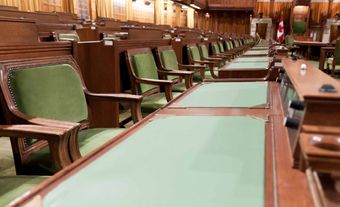Closure
Closure is a procedural provision allowing the Government to curtail debate in the HOUSE OF COMMONS and bring on a vote. A remedy for FILIBUSTERING, it entails 2 different decisions by the House: the vote to apply closure, and then the vote (or votes) on the business being closed. Closure takes 2 days. If the required oral notice is given on a Monday, closure will be moved and the closure vote taken (without debate) after routine proceedings on Tuesday; if the closure motion carries, the rest of that sitting is spent on the business to be closed, which is put to the vote at the end of the sitting. With closure on, the House sits late, with the vote (or votes) coming soon after 1:00 AM.
The use of closure is highly controversial. The Opposition cries, "Dictatorship!"; the Government cries, "Filibuster!" Added to the Standing Orders in 1913, the rule was used 18 times before 1982, 4 times during the PIPELINE DEBATE in 1956. It was used to bring on the vote for concurrence in the flag committee report in 1964, and to add 3 new Standing Orders: SO 115, 116 and 117, which provide for limitation of debate at each stage of a bill's passage through the House (see ALLOTMENT OF TIME), and in 1987 on the debate on CAPITAL PUNISHMENT. It was used as recently as 1995 to limit debate to the Liberal government's Electoral Boundries Readjustment Act, an Act which ultimately failed to gain approval in the Conservative-dominated Senate.

 Share on Facebook
Share on Facebook Share on X
Share on X Share by Email
Share by Email Share on Google Classroom
Share on Google Classroom


.jpg)